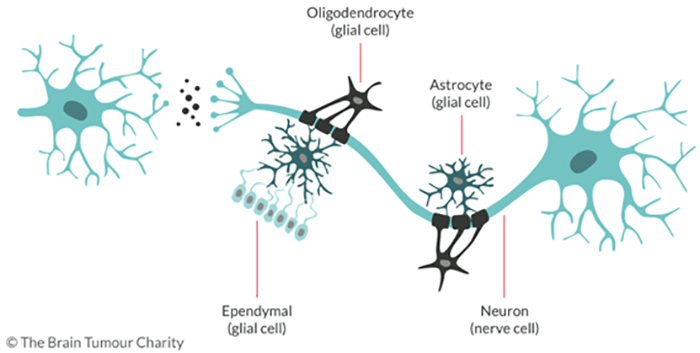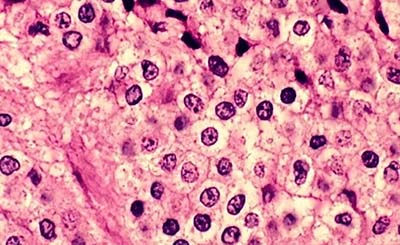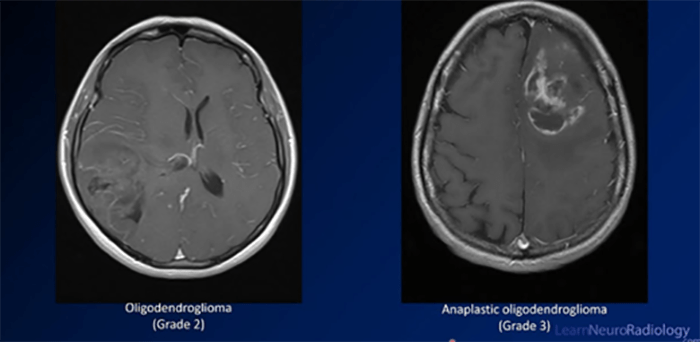- In-Stock Tumor Cell Lines
- Human Orbital Fibroblasts
- Human Microglia
- Human Pulmonary Alveolar Epithelial Cells
- Human Colonic Fibroblasts
- Human Type II Alveolar Epithelial Cells
- Human Valvular Interstitial Cells
- Human Thyroid Epithelial Cells
- C57BL/6 Mouse Dermal Fibroblasts
- Human Alveolar Macrophages
- Human Dermal Fibroblasts, Adult
- Human Lung Fibroblasts, Adult
- Human Retinal Muller Cells
- Human Articular Chondrocytes
- Human Retinal Pigment Epithelial Cells
- Human Pancreatic Islets of Langerhans Cells
- Human Kidney Podocyte Cells
- Human Renal Proximal Tubule Cells
Oligodendroglioma is a primary glial brain tumor. These tumor cells develop from a type of glial cell, which is known as an oligodendrocyte. Oligodendrocytes produce a fatty, protective covering (called myelin) of the nerve cells, form the supportive tissue, insulates nerve fibers in the central nervous system (CNS).
Oligodendrogliomas mostly occur in the white matter, but they can also be found elsewhere like the cortex, the outer layer of the brain. The tumors can spread through the central nervous system via the fluid around the brain and spinal cord rarely spread outside of the CNS to other organs.

Fig1. An image that describes oligodendrocyte cells

Figure2. oligodendrocyte cells under microscope
Oligodendrogliomas that harbor 1p/19q codeletion have 2 defining features in vivo: slow growth and chemosensitivity .
Grades of oligodendroglioma
Oligodendrogliomas are divided into two types based on their characteristics:
1. Grade II oligodendrogliomas are low-grade tumors. This means the tumor cells grow slowly and invade nearby normal tissue. In many cases, they form years before being diagnosed as no symptoms appear.
2. Grade III oligodendrogliomas are also called anaplastic oligodendrogliomas which are malignant (cancerous). This means they are fast-growing tumors.

Figure 3. Imaging of oligodendroglioma Grade 2 & 3
The Incidence of Oligodendrogliomas
In the US, with 35,000 new cases diagnosed as cancer, primary brain tumors represent only 2% of these new cases, oligodendrogliomas takes up about 3% of all brain tumors. According to the Central Brain Tumor Registry of the United States (CBTRUS), the prevalence of oligodendrogliomas, including anaplastic oligodendrogliomas, is approximately 1/300,000. Based on these data, it appears that oligodendrogliomas are rare tumors.
Oligodendroglioma can occur at any age, but most often affects adults between the ages of 35 and 44, rarely found in children. Oligodendrogliomas occur more often in males than in females. In addition, white and non-Hispanic people are more commonly diagnosed with oligodendroglioma.
Oligodendroglioma Cell Lines
As a rare tumor, there are only a few oligodendroglioma cell lines available: Hs683 Cell Line, NCH612 Cell Line, and KG-1C Cell Line.
Hs683
The Hs683 cells were isolated from explant cultures of a glioma taken from the left temporal lobe of a 76-year-old male Caucasian. As an oligodendroglioma model, the Hs683 cells are 1p19q co-deleted, display very highly sensitive to chemotherapy in vivo, weak (if any) vimentin expression and high levels of integrin β4 expression. Hs683 cells do not express the human 1p-distal ATAD 3B gene, which is highly expressed in astroglioma cells. However, they contain only one Notch2 gene copy per diploid genome as do oligodendrogliomas, in which loss of the 1p centromeric marker within intron 12 of the Notch2 gene is associated with a favorable prognosis in oligodendroglioma patients.
NCH612
The NCH612 cell line is a grade III oligodendroglioma cell line, shows a high grade endogenous IDH1 mutant. In the IDH1 mutant cell lines, 2HG levels were increased compared to the IDH1 wild-type cell lines. The NCH612 has the highest levels of intracellular 2HG. The level of 2HG in NCH612 displayed a twenty-fold increase over the NCH421 cell line, the highest 2HG wild-type cell line observed.
The KG-1C cell line was derived from a human mixed glioma. The cell line has human oligodendrocytes characteristics, such as the production of S-100 protein, specific to neural tissue, and negative immunoreactivity for astrocyte-specific GFAP as well as the resemblance of cell morphology with primary cultured oligodendrocytes.
In recent years, with the growing Oligodendroglioma Treatment market, the oligodendroglioma cell lines will be an important tool for further research.
AcceGen has now owned oligodendroglioma cell line Hs683, NCH612, and KG-1-C, if you are interested in these cell lines, inquiry online or contact us at [email protected].

Copyright - Unless otherwise stated all contents of this website are AcceGen™ All Rights Reserved – Full details of the use of materials on this site please refer to AcceGen Editorial Policy – Guest Posts are welcome, by submitting a guest post to AcceGen you are agree to the AcceGen Guest Post Agreement – Any concerns please contact [email protected]








